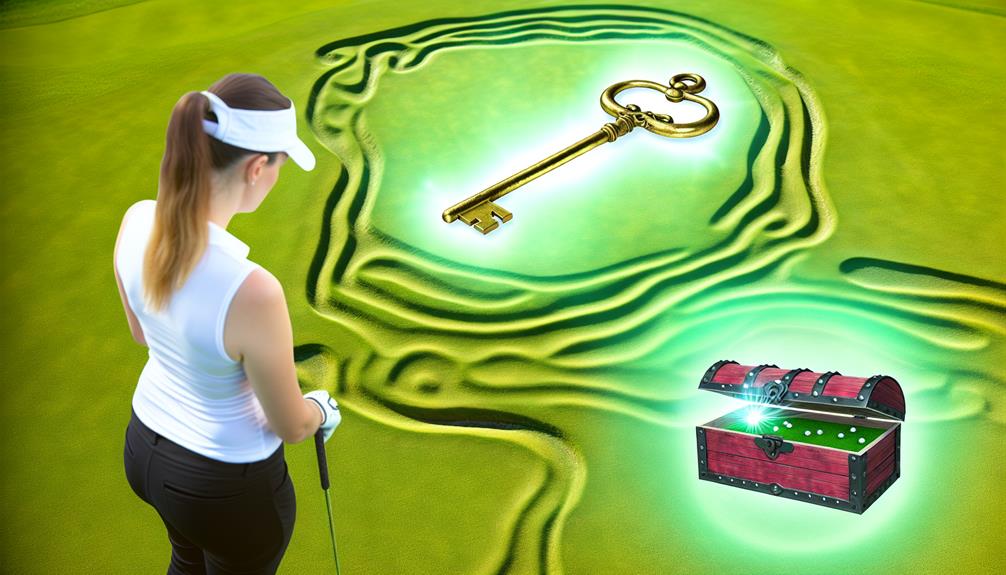You might think that deciphering the subtleties of a golf course's greens is a skill reserved for the pros, but that's not the case. With a keen eye and a touch of insight, you can unlock the very secrets that make the difference between a good putter and a great one.
It's not just about having a feel for the grass under your feet, but also understanding the textures, slopes, terrains, and the speed of the greens. So, let's take a shot at it, shall we?
Who knows, by the end of our discussion, you could be sinking putts with the confidence of a seasoned pro.
Understanding Golf Course Green Basics
Ever wondered what makes a golf course green so distinctive and challenging to predict? It's all part of the magic of green maintenance, a crucial factor that can make or break your golf experience.
Let's start with the basics. You've got to understand that greens aren't just about the color. They're a complex mix of different turf varieties, each with its own feel, speed, and reaction to the golf ball. Bentgrass, for example, is a popular choice for many high-end courses due to its dense, smooth texture that allows for fast rolling balls. Bermuda grass, on the other hand, is more common in warmer climates, and it's a bit more grainy, which can alter the ball's trajectory.
But it's not just about the grass type. The maintenance of a golf course green plays a significant role too. This includes regular mowing, watering, and aeration to keep the turf healthy and playable. Factors such as the direction of mowing and the moisture level can significantly affect how your ball rolls on the green.
Deciphering Different Green Textures
As a golfer, you'll quickly learn to recognize the subtle textures of different greens, understanding how each one can influence your game. Green maintenance is crucial in determining the texture variations you'll encounter. A well-maintained green will typically feel smooth and firm under your feet, providing a predictable roll for your ball.
However, not all greens are maintained equally. Some may be softer due to less frequent mowing or lack of aeration, which can slow your ball down and make your putts less accurate. Moreover, the type of grass used also contributes to texture variations. For instance, Bermuda grass greens often have a grain that can influence the roll of the ball, while Bentgrass greens tend to be denser and smoother.
Understanding these differences is key to adapting your play style. On softer greens, you'll need to hit the ball harder to achieve the same distance. On greens with noticeable grain, you'll need to adjust your aim to account for the way the ball will be pulled by the grass.
Analyzing Slope and Terrain
While understanding the texture of greens is fundamental, you'll also need to master analyzing the slope and terrain, which can significantly affect your ball's path and speed. Slope determines the ball's direction, while terrain affects how much the ball will roll. A slight incline can shift your ball's trajectory, so it's imperative to adjust your aim accordingly.
Grain Direction Recognition is crucial here. The grain refers to the direction in which the grass grows. It's influenced by factors like sunlight, wind, and water drainage. Your ball's speed and path can be dramatically affected by the grain, especially on Bermuda grass greens. So, you'll need to learn to recognize the subtle signs of grain direction—like the grass's sheen and the direction of the mower's cut—to improve your putting accuracy.
Moisture Impact Analysis is another important skill in reading greens. Wet grass, whether from dew or a recent rain, can slow your ball significantly. Dry greens, conversely, can make your ball roll faster and farther. Mastering the art of assessing moisture levels and adjusting your stroke power can give you an edge in your game.
Mastering Green Speed Interpretation
Mastering the interpretation of green speed is a crucial yet intricate aspect of your golf game, directly influencing your ability to accurately predict the ball's travel distance. It's not just about how hard you hit the ball but how well you understand the green's characteristics.
In the world of golf, the speed of the green is measured by a Stimpmeter. This tool rolls a ball down a ramp onto the green, and the distance it travels in feet is the 'Stimp' rating of the green. The higher the number, the faster the green. But how does this translate to your putting techniques?
Well, on fast greens, it's all about finesse. You'll need to adapt your speed control, making your strokes softer and more subtle. Conversely, on slower greens, you may need to strike the ball with more force. The key is to practice and adjust your stroke depending on the green's speed.
Applying Knowledge for Accurate Putts
Your understanding of the green's speed is a powerful tool in the quest for accurate putts. This insight, combined with your knowledge of putt alignment and stroke mechanics, can significantly improve your game.
Proper putt alignment is the first step towards a successful putt. It's not just about where you're aiming, but also how your body is positioned relative to the ball and the target. Your feet, hips, and shoulders should all be parallel to your target line. This alignment gives you the best chance of making a straight stroke, which in turn increases the likelihood of your ball ending up where you want it to.
Stroke mechanics are equally important. A good stroke has a smooth rhythm and maintains a square clubface throughout the stroke. It's a back-and-forth motion, like a pendulum, with a consistent tempo. It all begins with a good setup: bend at the hips, let your arms hang freely, and grip the club lightly.

